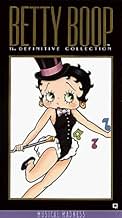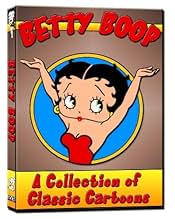Añade un argumento en tu idiomaIn her only color cartoon, Betty Boop goes to the ball thanks to her fairy godmother; later, only her foot fits the glass slipper.In her only color cartoon, Betty Boop goes to the ball thanks to her fairy godmother; later, only her foot fits the glass slipper.In her only color cartoon, Betty Boop goes to the ball thanks to her fairy godmother; later, only her foot fits the glass slipper.
- Dirección
- Guión
- Reparto principal
Jack Mercer
- Various
- (voz)
- (sin acreditar)
William Pennell
- Pumpkin
- (sin acreditar)
Bonnie Poe
- Betty Boop
- (voz)
- (sin acreditar)
- …
Reseñas destacadas
Max & Dave Fleischer & co. were among the very best of the creators of novel and surprising applications of animation from the late teens through the entire decade of the 1930's. For "Poor Cinderella", they must have noted Disney's stunning "Flowers And Trees", produced in 1931 and released the following year. The latter is generally credited as being the first full color process American cartoon, as opposed to two strip color which emphasized either blues or greens at the expense of certain shades that were lost to the lesser and less costly techniques of the day. For budgetary reasons, the ever inventive Fleischer Bros. developed their own "Cinecolor" approach, which was a variant on the two-strip color format. Although it apparently never quite caught on, they had applied for a patent while releasing their astoundingly beautiful and hysterically surreal and laugh-laden Boop masterpiece in 1934, the only Betty Boop color cartoon.
Combining their proprietary Rotoscope technique along with other dimension enhancing toolkit tricks, few cartoon shorts have ever matched this effort for sheer entertainment value. They did try saving money on the color, as mentioned, but the whole production was obviously a very expensive endeavor, when all its components are considered in sum. The results offer a lasting tribute to the art and magic of 1930's animation.
As a Depression-era vehicle, good jobs were scarce but the Fleischer team's uproarious talent sported young and brash animators who were willing to push the envelope of sensibilities and censors alike, much to our delight. Even the closing sequence is incredibly absurd, and gems like this will forever prevail.
Betty had already helped launch the Popeye series a year earlier, so by 1934 the Fleischers had their distinctly urban stamp firmly planted under two cartoon banners aimed as much, if not more, at adults as the kids. If that weren't true, they wouldn't have always had to play "duck and cover" with the ever-present Hays commission, censor gavel at the ready. Thanks to the Fleischer folks and all involved parties, for the guts, the creative ambition, the sheer genius, and the uncompromising quality of whichever production standards were chosen to collectively coalesce into a cartoon gem for the ages. This is a must see.
Combining their proprietary Rotoscope technique along with other dimension enhancing toolkit tricks, few cartoon shorts have ever matched this effort for sheer entertainment value. They did try saving money on the color, as mentioned, but the whole production was obviously a very expensive endeavor, when all its components are considered in sum. The results offer a lasting tribute to the art and magic of 1930's animation.
As a Depression-era vehicle, good jobs were scarce but the Fleischer team's uproarious talent sported young and brash animators who were willing to push the envelope of sensibilities and censors alike, much to our delight. Even the closing sequence is incredibly absurd, and gems like this will forever prevail.
Betty had already helped launch the Popeye series a year earlier, so by 1934 the Fleischers had their distinctly urban stamp firmly planted under two cartoon banners aimed as much, if not more, at adults as the kids. If that weren't true, they wouldn't have always had to play "duck and cover" with the ever-present Hays commission, censor gavel at the ready. Thanks to the Fleischer folks and all involved parties, for the guts, the creative ambition, the sheer genius, and the uncompromising quality of whichever production standards were chosen to collectively coalesce into a cartoon gem for the ages. This is a must see.
10Popeye-8
Before moving on to their prolific (and highly successful) POPEYE series (as well as into their unfortunate GABBY series--just imagine Elmer Fudd without his macho sex appeal), Paramount's Fleischer brothers poured their creative genius into BETTY BOOP. This is their finest B-B cartoon, and may just be their finest EVER, period.
Using their 3-D filming process (and a unheard-of budget for a cartoon short), they adapted the Cinderella legend to Betty, adding some marvelous songs and (likely roto-scoped) beautiful dance numbers. For reasons not told, this was the only Betty Boop cartoon ever done in color--a tragedy.
Look for versions with the original opening titles intact--even the titles show that this was a project of love (and yes, money). Plus, Betty's as sexy an ingenue as ever thanks to Technicolor.
Using their 3-D filming process (and a unheard-of budget for a cartoon short), they adapted the Cinderella legend to Betty, adding some marvelous songs and (likely roto-scoped) beautiful dance numbers. For reasons not told, this was the only Betty Boop cartoon ever done in color--a tragedy.
Look for versions with the original opening titles intact--even the titles show that this was a project of love (and yes, money). Plus, Betty's as sexy an ingenue as ever thanks to Technicolor.
Long before Rodgers and Hammerstein had the idea of musicalizing Cinderella, Betty Boop made the midnight pumpkin change tunefully, with verve, sex and good story editing. The plot is trimmed to its essentials, the splendid backgrounds may have influenced the Disney Beauty and the Beast, and the closing shot of the Pinocchio-nosed sisters wraps everything up with a laugh.
10llltdesq
This is an absolutely beautiful cartoon! Most Fleischer shorts were quite visually striking, to be sure, but Betty Boop only had one color cartoon-this one. While in many ways it's good that black and white was used for most of her cartoons, the sweep of this cartoon cried out for color. The Fleischers were likely also hoping that Betty's popularity would boost interest in the Color Classics series that they were starting. Betty as Cinderella was certainly fitting-after all, Cinderella did ultimately become a princess when she married the prince and Betty Boop is cartoon royalty. Wonderful effort from the brothers Max and Dave. In print and available. Most highly recommended.
This is the only color cartoon we have of the delicious Miss Boop, incidentally made on the cusp of when the Hayes Code was enforced. So we have her at her bouncing sexist. And we discover that she is a redhead!
Pretty much all the material that Disney later covered in his feature cartoons had been done in a Boop version first, and with more energy. I think if Fleischer had arranged the backing to make feature cartoons, we'd now be visiting BoopLand in California, Florida and Paris.
Oh, there's another unique thing here. Betty does her trademarked butt dancing but when with her prince at the ball, has an equally sexy smooth ballroom dance. I think it is the only non-jazzy dance in all the Boop cartoons.
Ted's Evaluation -- 3 of 3: Worth watching.
Pretty much all the material that Disney later covered in his feature cartoons had been done in a Boop version first, and with more energy. I think if Fleischer had arranged the backing to make feature cartoons, we'd now be visiting BoopLand in California, Florida and Paris.
Oh, there's another unique thing here. Betty does her trademarked butt dancing but when with her prince at the ball, has an equally sexy smooth ballroom dance. I think it is the only non-jazzy dance in all the Boop cartoons.
Ted's Evaluation -- 3 of 3: Worth watching.
¿Sabías que...?
- CuriosidadesRather than making animated backgrounds using drawings the Fleischers pioneered the idea of using either models or cutouts mounted on a turntable. The table was slowly spun and photographed. The foreground animation was then placed in front of the photographed backgrounds. This not only saved hundred of hours of drawing but also lent a 3D effect to the back ground. It was used here and in numerous "Popeye" cartoons.
- Versiones alternativasOne 1980s VHS release of "Poor Cinderella" has the entire color cartoon presented in black-and-white.
- ConexionesEdited into Betty Boop Confidential (1995)
- Banda sonoraPoor Cinderella
Written by Charles Tobias, Murray Mencher, Jack Scholl
Sung by Betty Boop
Performed by Phil Spitalny and his orchestra
Later sung by Betty and by the singer with the megaphone
Selecciones populares
Inicia sesión para calificar y añadir a tu lista para recibir recomendaciones personalizadas
Detalles
- Duración11 minutos
- Relación de aspecto
- 1.37 : 1
Contribuir a esta página
Sugerir un cambio o añadir el contenido que falta

Principal laguna de datos
By what name was Poor Cinderella (1934) officially released in Canada in English?
Responde
















